
LLaVA-OneVision-1.5
Fully Open Framework for Democratized Multimodal Training
Stars: 368
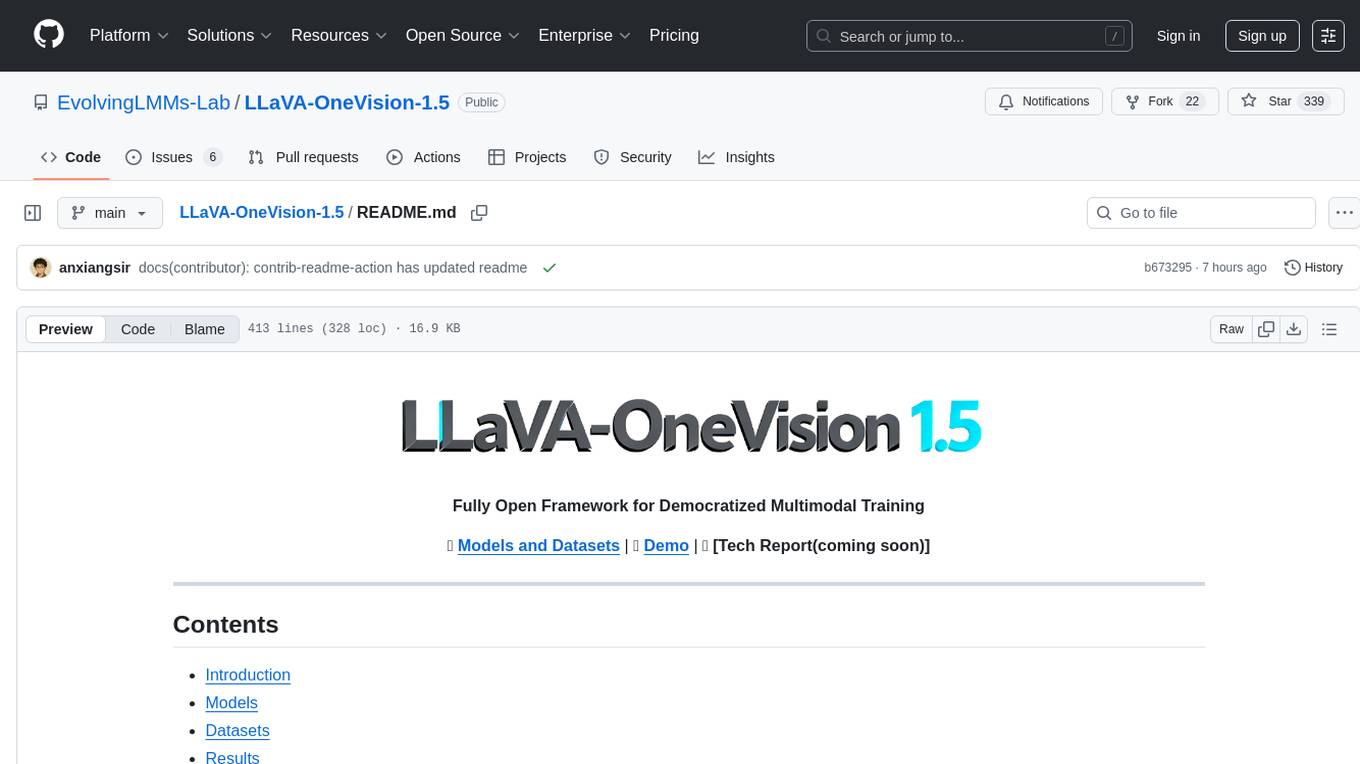
LLaVA-OneVision 1.5 is a fully open framework for democratized multimodal training, introducing a novel family of large multimodal models achieving state-of-the-art performance at lower cost through training on native resolution images. It offers superior performance across multiple benchmarks, high-quality data at scale with concept-balanced and diverse caption data, and an ultra-efficient training framework with support for MoE, FP8, and long sequence parallelization. The framework is fully open for community access and reproducibility, providing high-quality pre-training & SFT data, complete training framework & code, training recipes & configurations, and comprehensive training logs & metrics.
README:
Fully Open Framework for Democratized Multimodal Training
🤗 Models and Datasets | 🖥️ Demo | 📄 Tech Report
- Introduction
- Models
- Datasets
- Results
- Quick Start with HuggingFace
- Evaluation
- Quick Start For Training
- Fully Reproducing Guide
- Citation
- Acknowledgement
LLaVA-OneVision1.5 introduces a novel family of fully open-source Large Multimodal Models (LMMs) that achieves state-of-the-art performance with substantially lower cost through training on native resolution images.
-
Superior Performance A family of fully open-source large multimodal models demonstrating
- Superior performance across multiple multimodal benchmarks
- outperforming Qwen2.5-VL in most evaluation tasks.
-
High-Quality Data at Scale Meticulously curated pre-training and SFT data with rigorous filtering and quality control.
- Concept-balanced, highly diverse, high-quality caption data
- Comprehensive instruction fine-tuning data covering a wide range of tasks
-
Ultra-Efficient Training Framework Complete end-to-end training framework designed for maximum efficiency:
- $16000 total budget for full model training on A100 GPUs ($0.6 per GPU/Hour)
- Built on MegatronLM with support for MoE, FP8, and long sequence parallelization
- Optimized codebase for cost-effective scaling
-
Fully Open Framework for community access and reproducibility:
- High-quality pre-training & SFT data
- Complete training framework & code
- Training recipes & configurations
- Comprehensive training logs & metrics
| Model | HF Link | Training Log |
|---|---|---|
| LLaVA-OV-1.5-4B-Instruct | 🤗 HF / 4B-Instruct | 📈 Tensorboard |
| LLaVA-OV-1.5-8B-Instruct | 🤗 HF / 8B-Instruct | 📈 Tensorboard |
(a) The vocabulary coverage proportion in the LLaVA-OneVision-1.5 Mid-Training dataset before and after concept balancing. (b) Distribution of data sources within the LLaVA-OneVision-1.5 Mid-Training dataset. (c) Distribution of data sources within the LLaVA-OneVision-1.5 Insturct dataset.
| Description | Link | Status |
|---|---|---|
| LLaVA-OV-1.5-Mid-Training-85M | 🤗HF / Mid-Training 85M | Uploading… |
| LLaVA-OV-1.5-Instruct | 🤗HF / Insturct-Data | Uploading… |
All evaluations were conducted using lmms_eval.
from transformers import AutoTokenizer, AutoProcessor, AutoModelForCausalLM
from qwen_vl_utils import process_vision_info
model_path = "lmms-lab/LLaVA-One-Vision-1.5-8B-Instruct"
# default: Load the model on the available device(s)
model = AutoModelForCausalLM.from_pretrained(
model_path, torch_dtype="auto", device_map="auto", trust_remote_code=True
)
# default processer
processor = AutoProcessor.from_pretrained(model_path, trust_remote_code=True)
messages = [
{
"role": "user",
"content": [
{
"type": "image",
"image": "https://qianwen-res.oss-cn-beijing.aliyuncs.com/Qwen-VL/assets/demo.jpeg",
},
{"type": "text", "text": "Describe this image."},
],
}
]
# Preparation for inference
text = processor.apply_chat_template(
messages, tokenize=False, add_generation_prompt=True
)
image_inputs, video_inputs = process_vision_info(messages)
inputs = processor(
text=[text],
images=image_inputs,
videos=video_inputs,
padding=True,
return_tensors="pt",
)
inputs = inputs.to("cuda")
# Inference: Generation of the output
generated_ids = model.generate(**inputs, max_new_tokens=1024)
generated_ids_trimmed = [
out_ids[len(in_ids) :] for in_ids, out_ids in zip(inputs.input_ids, generated_ids)
]
output_text = processor.batch_decode(
generated_ids_trimmed, skip_special_tokens=True, clean_up_tokenization_spaces=False
)
print(output_text)# pip install git+https://github.com/EvolvingLMMs-Lab/lmms-eval.git
accelerate launch --num_processes=8 --main_process_port 12399 -m lmms_eval \
--model=llava_onevision1_5 \
--model_args=pretrained=lmms-lab/LLaVA-OneVision-1.5-8B-Instruct,attn_implementation=flash_attention_2,max_pixels=3240000 \
--tasks=mmmu_val,mmmu_pro_standard,mmbench_en_test,mmerealworld,mmerealworld_cn,ai2d,ai2d_no_mask,vstar_bench,chartqa,charxiv,docvqa_test,mathvista_testmini,mmstar,scienceqa \
--batch_size=1
We strongly recommend using the docker environment for a seamless experience. The following instructions are tailored for the A100 80GB GPU environment.
# Clone repository
git clone https://github.com/EvolvingLMMs-Lab/LLaVA-OneVision-1.5.git
cd LLaVA-OneVision-1.5
docker build -t llava_megatron:25.04 .
# Run container with -w to set working directory directly to the mounted volume
docker run -it --gpus all \
--ipc host --net host --privileged --cap-add IPC_LOCK \
--ulimit memlock=-1 --ulimit stack=67108864 --rm \
-v $(pwd):/workspace/LLaVA-OneVision-1.5 \
-w /workspace/LLaVA-OneVision-1.5 \
--name "llava_megatron_container" \
llava_megatron:25.04 /bin/bashYou have two options to get started with LLaVA-OneVision-1.5-stage-0:
Download our LLaVA-OneVision-1.5-4B-stage0 model directly from HuggingFace.
Alternatively, you can merge the initial weights from the original ViT and LLM:
python ds/merge_model.py \
--vit_path DeepGlint-AI/rice-vit-large-patch14-560 \
--llm_path Qwen/Qwen3-4B-Instruct-2507 \
--output LLaVA-OneVision-1.5-4B-stage0Note: When merging weights, the adapter component will be initialized with default values.
Convert the model from HuggingFace format to Megatron format:
AIAK_TRAINING_PATH=/workspace/LLaVA-OneVision-1.5 bash examples/llava_ov_1_5/convert/convert_4b_hf_to_mcore.sh \
LLaVA-OneVision-1.5-4B-stage0 \
LLaVA-OneVision-1.5-4B-stage0_mcore_tp1_pp1 \
1 1Download LLaVA from LLaVA-558K-Webdataset.
# ============================================================
# Required environment variables:
# AIAK_TRAINING_PATH Root directory of the AIAK-Training-LLM project
# DATA_PATH Directory with WebDataset shards (.tar) for pretraining
# TOKENIZER_PATH Hugging Face tokenizer directory
# CHECKPOINT_PATH Megatron-formatted checkpoint directory (e.g., mcore TP1/PP1)
# SAVE_CKPT_PATH Output directory for saving training checkpoints
AIAK_TRAINING_PATH=/workspace/LLaVA-OneVision-1.5 \
DATA_PATH=LLaVA-558K-Webdataset \
TOKENIZER_PATH=LLaVA-OneVision-1.5-4B-stage0 \
CHECKPOINT_PATH=LLaVA-OneVision-1.5-4B-stage0_mcore_tp1_pp1 \
bash examples/llava_ov_1_5/quick_start/stage_1_alignment_llava_ov_4b.shDownload our lightweight packed subset from LLaVA-OneVision-1.5-Mid-Training-Quick-Start-3M-Webdataset.
# ============================================================
# Convert model to release format
bash examples/llava_ov_1_5/convert/convert_4b_mcore_to_release.sh \
stage_1_alignment_llava_ov_4b/iter_0002500/ \
stage_1_alignment_llava_ov_4b_release 1 1
# ============================================================
# Launch
AIAK_TRAINING_PATH=/workspace/LLaVA-OneVision-1.5 \
DATA_PATH=LLaVA-OneVision-1.5-Mid-Training-Quick-Start-3M-Webdataset \
TOKENIZER_PATH=LLaVA-OneVision-1.5-4B-stage0 \
CHECKPOINT_PATH=stage_1_alignment_llava_ov_4b_release \
bash examples/llava_ov_1_5/quick_start/stage_1.5_mid_training_llava_ov_4b.shDownload LLaVA-NeXT-780k-webdataset at LLaVA-NeXT-780K Dataset.
# ============================================================
# Convert model to release format
bash examples/llava_ov_1_5/convert/convert_4b_mcore_to_release.sh \
stage_1.5_mid_training_llava_ov_4b/iter_0020000/ \
stage_1.5_mid_training_llava_ov_4b_release 1 1
# ============================================================
# # Launch
AIAK_TRAINING_PATH=/workspace/LLaVA-OneVision-1.5 \
DATA_PATH=LLaVA-NeXT-780k-Webdataset \
TOKENIZER_PATH=LLaVA-OneVision-1.5-4B-stage0 \
CHECKPOINT_PATH=stage_1.5_mid_training_llava_ov_4b_release \
bash examples/llava_ov_1_5/quick_start/stage_2_instruct_llava_ov_4b.shAIAK_TRAINING_PATH=/workspace/LLaVA-OneVision-1.5 \
bash examples/llava_ov_1_5/convert/convert_4b_mcore_to_hf.sh \
stage_2_instruct_llava_ov_4b/iter_0003500 \
LLaVA-OneVision-1.5-4B-3M-Mid-Training-780K-Instruct \
1 1
# Copy non-model files (e.g., tokenizer config) to the new directory
find LLaVA-OneVision-1.5-4B-stage0/ -type f -not -iname '*safetensors*' -exec cp {} LLaVA-OneVision-1.5-4B-3M-Mid-Training-780K-Instruct/ ';'# pip install git+https://github.com/EvolvingLMMs-Lab/lmms-eval.git
CUDA_VISIBLE_DEVICES=4,5,6,7 accelerate launch \
--num_processes=4 --main_process_port 12399 -m lmms_eval --model=llava_onevision1_5 --batch_size=1 --tasks=mme \
--model_args=pretrained=/workspace/LLaVA-OneVision-1.5/LLaVA-OneVision-1.5-4B-3M-Mid-Training-780K-Instruct,max_pixels=3240000[!TIP] More detailed reproduction steps for the complete process will be provided after the dataset upload is completed.
To improve model training efficiency, we implement offline sample packing:
- Download the Mid-Training-85M Dataset
- Pack the data into webdataset format, refer to Offline Padding-Free Data Packing
- Download the LLaVA-OneVision-1.5-Insturct-Data
- Convert the data into webdataset format, refer to Conversion for Mixed Instruction Data
Q4 2025 Key Deliverables:
- Ultra-efficient MoE Training
- Full Video Input LLM
Thanks so much to all of our amazing contributors!
|
anxiangsir |
yiyexy |
wideyard |
chengzheng345 |
mathCrazyy |
yunglechao |
RobitYadda |
If you find LLaVA-OneVision-1.5 useful in your research, please consider to cite the following related papers:
@inproceedings{LLaVA-OneVision-1.5,
title={LLaVA-OneVision-1.5: Fully Open Framework for Democratized Multimodal Training},
author={An, Xiang and Xie, Yin and Yang, Kaicheng and Zhang, Wenkang and Zhao, Xiuwei and Cheng, Zheng and Wang, Yirui and Xu, Songcen and Chen, Changrui and Wu, Chunsheng and Tan, Huajie and Li, Chunyuan and Yang, Jing and Yu, Jie and Wang, Xiyao and Qin, Bin and Wang, Yumeng and Yan, Zizhen and Feng, Ziyong and Liu, Ziwei and Li, Bo and Deng, Jiankang},
booktitle={arxiv},
year={2025}
}
@inproceedings{xie2025region,
title={Region-based Cluster Discrimination for Visual Representation Learning},
author={Xie, Yin and Yang, Kaicheng and An, Xiang and Wu, Kun and Zhao, Yongle and Deng, Weimo and Ran, Zimin and Wang, Yumeng and Feng, Ziyong and Miles, Roy and Elezi, Ismail and Deng, Jiankang},
booktitle={ICCV},
year={2025}
}
@article{lillava,
title={LLaVA-OneVision: Easy Visual Task Transfer},
author={Li, Bo and Zhang, Yuanhan and Guo, Dong and Zhang, Renrui and Li, Feng and Zhang, Hao and Zhang, Kaichen and Zhang, Peiyuan and Li, Yanwei and Liu, Ziwei and Li, Chunyuan},
journal={Transactions on Machine Learning Research}
year={2024}
}
We extend our sincere gratitude to AIAK team of the Baige AI computing platform from Baidu AI Cloud for providing the exceptional training framework. The outstanding capabilities of AIAK-Training-LLM and AIAK-Megatron have significantly accelerated our training process with remarkable efficiency. These cutting-edge frameworks have been instrumental in achieving our research goals. To get full AIAK support, you can contact Baidu Cloud.
We also thank the maintainers and contributors of the following open-source projects, whose work greatly inspired and supported our research:
- LLaVA: Large Language-and-Vision Assistant — LLaVA
- LLaVA-NeXT: Next-generation multi-modal assistant — LLaVA-NeXT
- lmms-eval: A standardized evaluation framework for Large Multimodal Models — lmms-eval
- Megatron-LM: Efficient, scalable training for large language models — Megatron-LM
- Qwen2.5-VL: Strong vision-language foundation model — Qwen2.5-VL
- InternVL: Open-source large-scale vision-language foundation model — InternVL
- Qwen3: Next-generation Qwen LLM — Qwen
- MetaCLIP: Scalable contrastive pretraining — MetaCLIP
- FineVision: Open Data Is All You Need — FineVision
For Tasks:
Click tags to check more tools for each tasksFor Jobs:
Alternative AI tools for LLaVA-OneVision-1.5
Similar Open Source Tools

LLaVA-OneVision-1.5
LLaVA-OneVision 1.5 is a fully open framework for democratized multimodal training, introducing a novel family of large multimodal models achieving state-of-the-art performance at lower cost through training on native resolution images. It offers superior performance across multiple benchmarks, high-quality data at scale with concept-balanced and diverse caption data, and an ultra-efficient training framework with support for MoE, FP8, and long sequence parallelization. The framework is fully open for community access and reproducibility, providing high-quality pre-training & SFT data, complete training framework & code, training recipes & configurations, and comprehensive training logs & metrics.
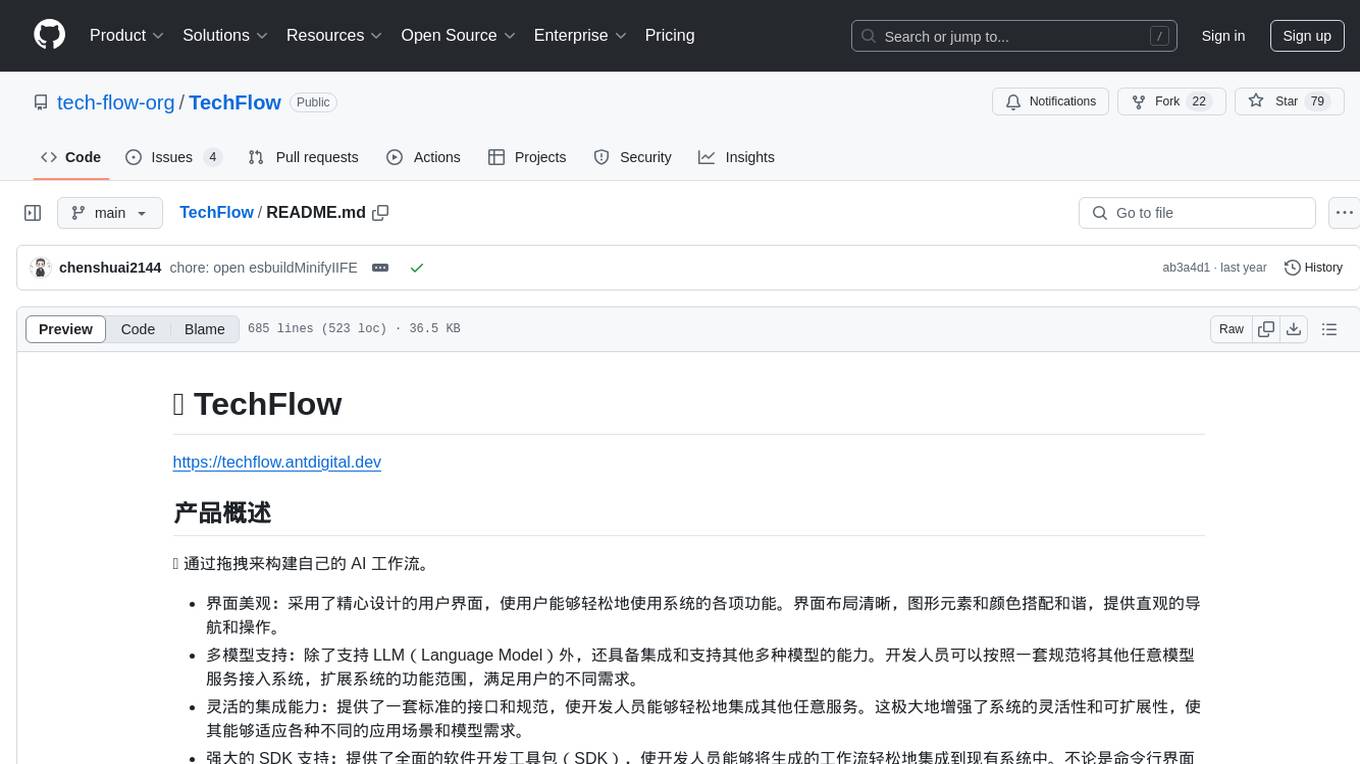
TechFlow
TechFlow is a platform that allows users to build their own AI workflows through drag-and-drop functionality. It features a visually appealing interface with clear layout and intuitive navigation. TechFlow supports multiple models beyond Language Models (LLM) and offers flexible integration capabilities. It provides a powerful SDK for developers to easily integrate generated workflows into existing systems, enhancing flexibility and scalability. The platform aims to embed AI capabilities as modules into existing functionalities to enhance business competitiveness.
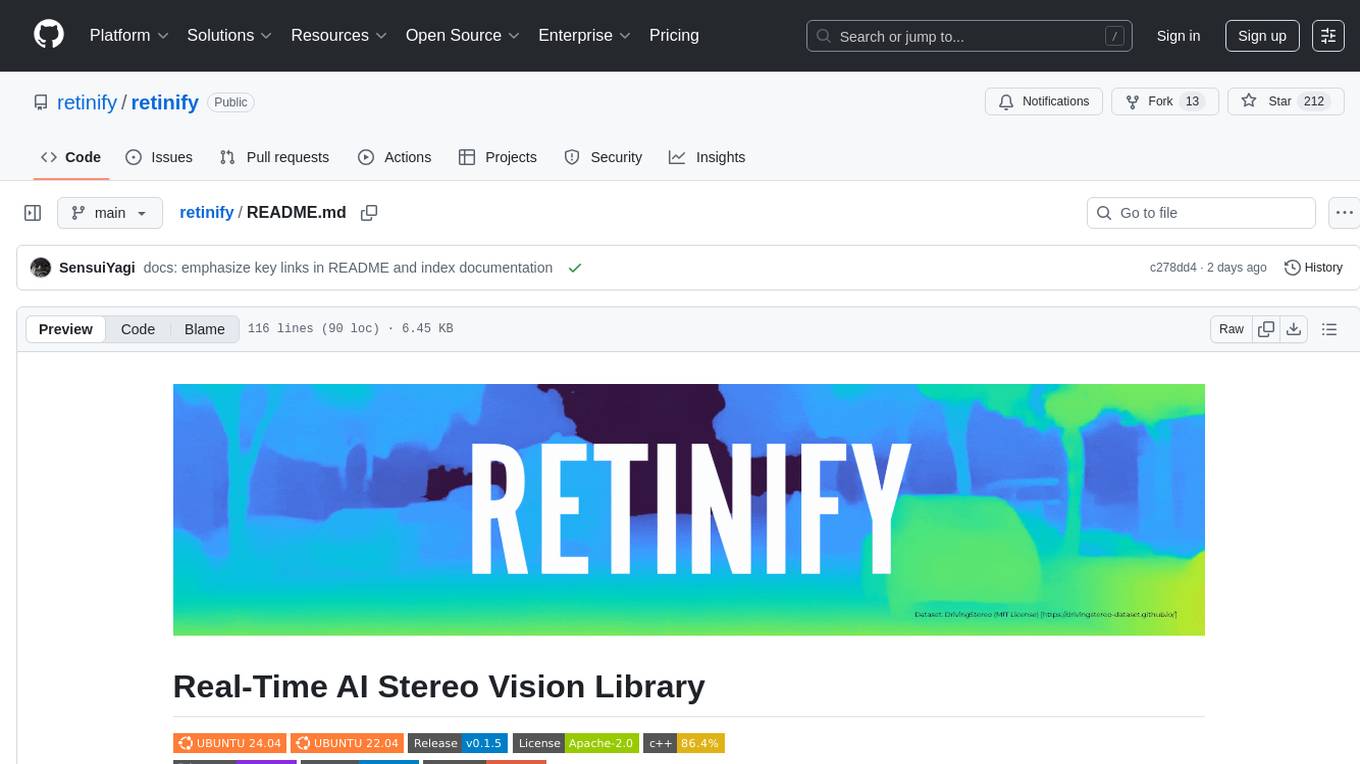
retinify
Retinify is an advanced AI-powered stereo vision library designed for robotics, enabling real-time, high-precision 3D perception by leveraging GPU and NPU acceleration. It is open source under Apache-2.0 license, offers high precision 3D mapping and object recognition, runs computations on GPU for fast performance, accepts stereo images from any rectified camera setup, is cost-efficient using minimal hardware, and has minimal dependencies on CUDA Toolkit, cuDNN, and TensorRT. The tool provides a pipeline for stereo matching and supports various image data types independently of OpenCV.

SuperAGI
SuperAGI is an open-source framework designed to build, manage, and run autonomous AI agents. It enables developers to create production-ready and scalable agents, extend agent capabilities with toolkits, and interact with agents through a graphical user interface. The framework allows users to connect to multiple Vector DBs, optimize token usage, store agent memory, utilize custom fine-tuned models, and automate tasks with predefined steps. SuperAGI also provides a marketplace for toolkits that enable agents to interact with external systems and third-party plugins.
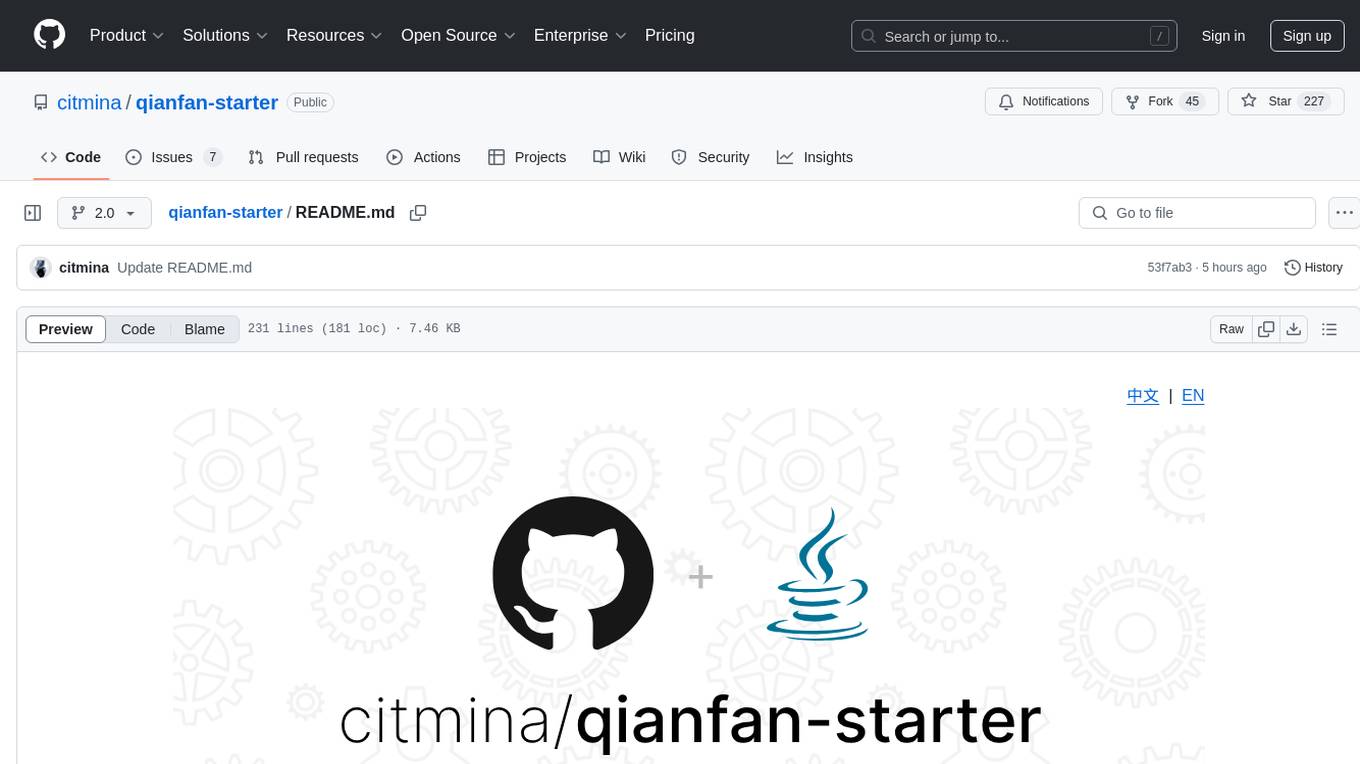
qianfan-starter
WenXin-Starter is a spring-boot-starter for Baidu's 'WenXin Workshop' large model, facilitating quick integration of Baidu's AI capabilities. It provides complete integration with WenXin Workshop's official API documentation, supports WenShengTu, built-in conversation memory, and supports conversation streaming. It also supports QPS control for individual models and queuing mechanism, with upcoming plugin support.
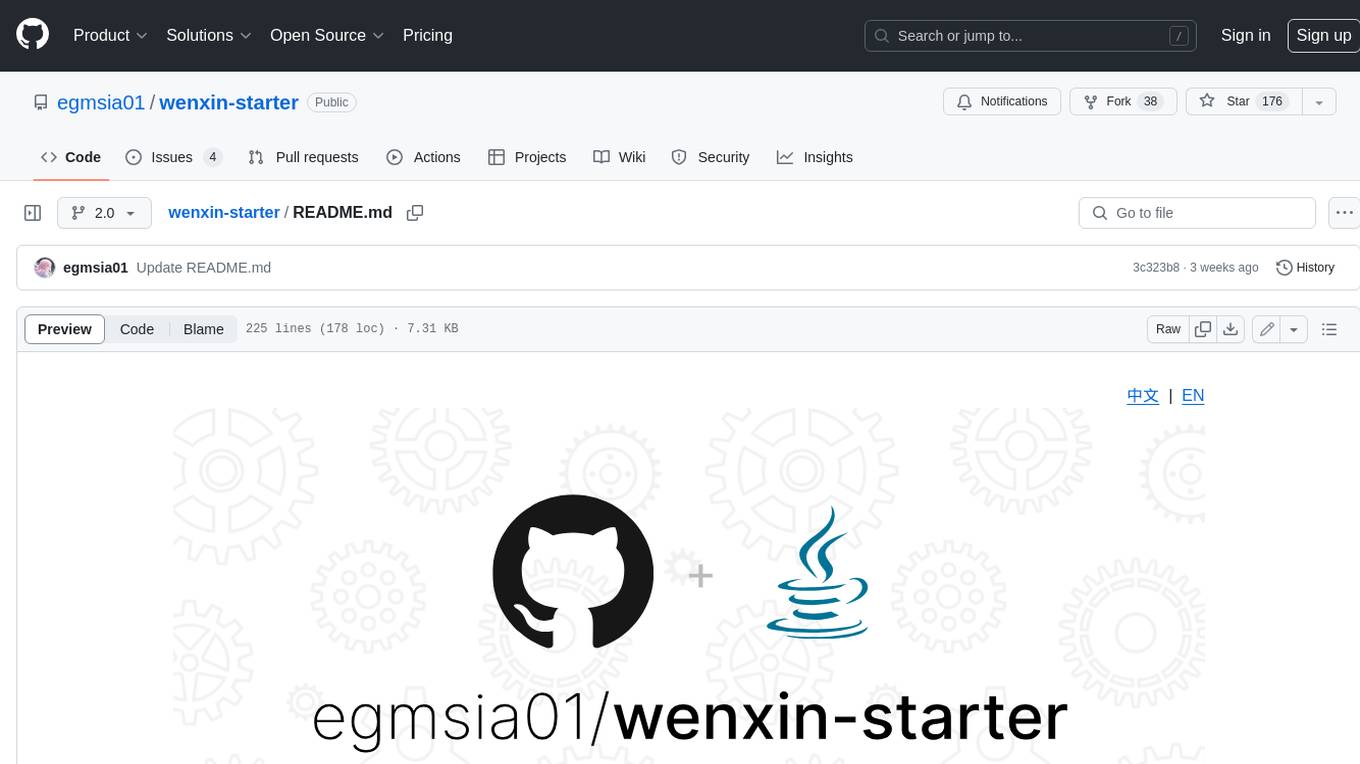
wenxin-starter
WenXin-Starter is a spring-boot-starter for Baidu's "Wenxin Qianfan WENXINWORKSHOP" large model, which can help you quickly access Baidu's AI capabilities. It fully integrates the official API documentation of Wenxin Qianfan. Supports text-to-image generation, built-in dialogue memory, and supports streaming return of dialogue. Supports QPS control of a single model and supports queuing mechanism. Plugins will be added soon.

L3AGI
L3AGI is an open-source tool that enables AI Assistants to collaborate together as effectively as human teams. It provides a robust set of functionalities that empower users to design, supervise, and execute both autonomous AI Assistants and Teams of Assistants. Key features include the ability to create and manage Teams of AI Assistants, design and oversee standalone AI Assistants, equip AI Assistants with the ability to retain and recall information, connect AI Assistants to an array of data sources for efficient information retrieval and processing, and employ curated sets of tools for specific tasks. L3AGI also offers a user-friendly interface, APIs for integration with other systems, and a vibrant community for support and collaboration.
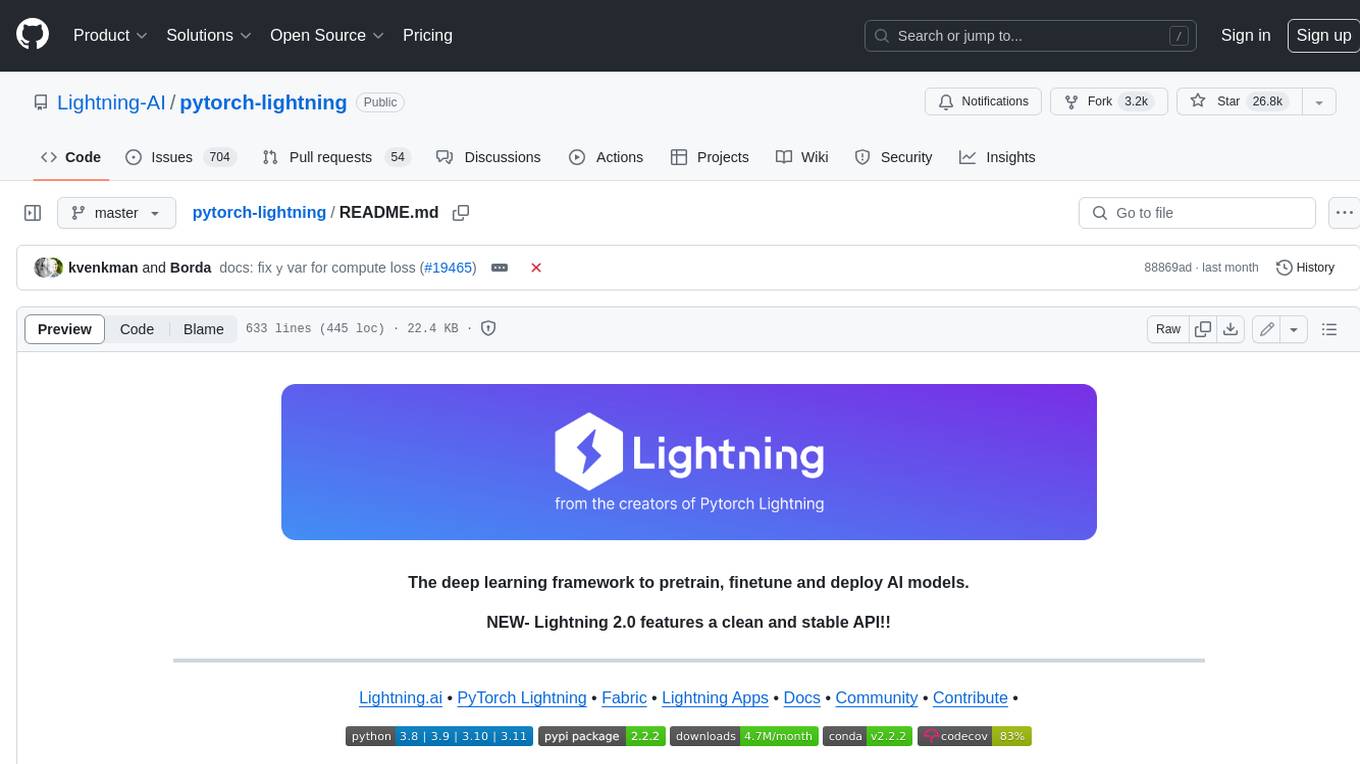
pytorch-lightning
PyTorch Lightning is a framework for training and deploying AI models. It provides a high-level API that abstracts away the low-level details of PyTorch, making it easier to write and maintain complex models. Lightning also includes a number of features that make it easy to train and deploy models on multiple GPUs or TPUs, and to track and visualize training progress. PyTorch Lightning is used by a wide range of organizations, including Google, Facebook, and Microsoft. It is also used by researchers at top universities around the world. Here are some of the benefits of using PyTorch Lightning: * **Increased productivity:** Lightning's high-level API makes it easy to write and maintain complex models. This can save you time and effort, and allow you to focus on the research or business problem you're trying to solve. * **Improved performance:** Lightning's optimized training loops and data loading pipelines can help you train models faster and with better performance. * **Easier deployment:** Lightning makes it easy to deploy models to a variety of platforms, including the cloud, on-premises servers, and mobile devices. * **Better reproducibility:** Lightning's logging and visualization tools make it easy to track and reproduce training results.
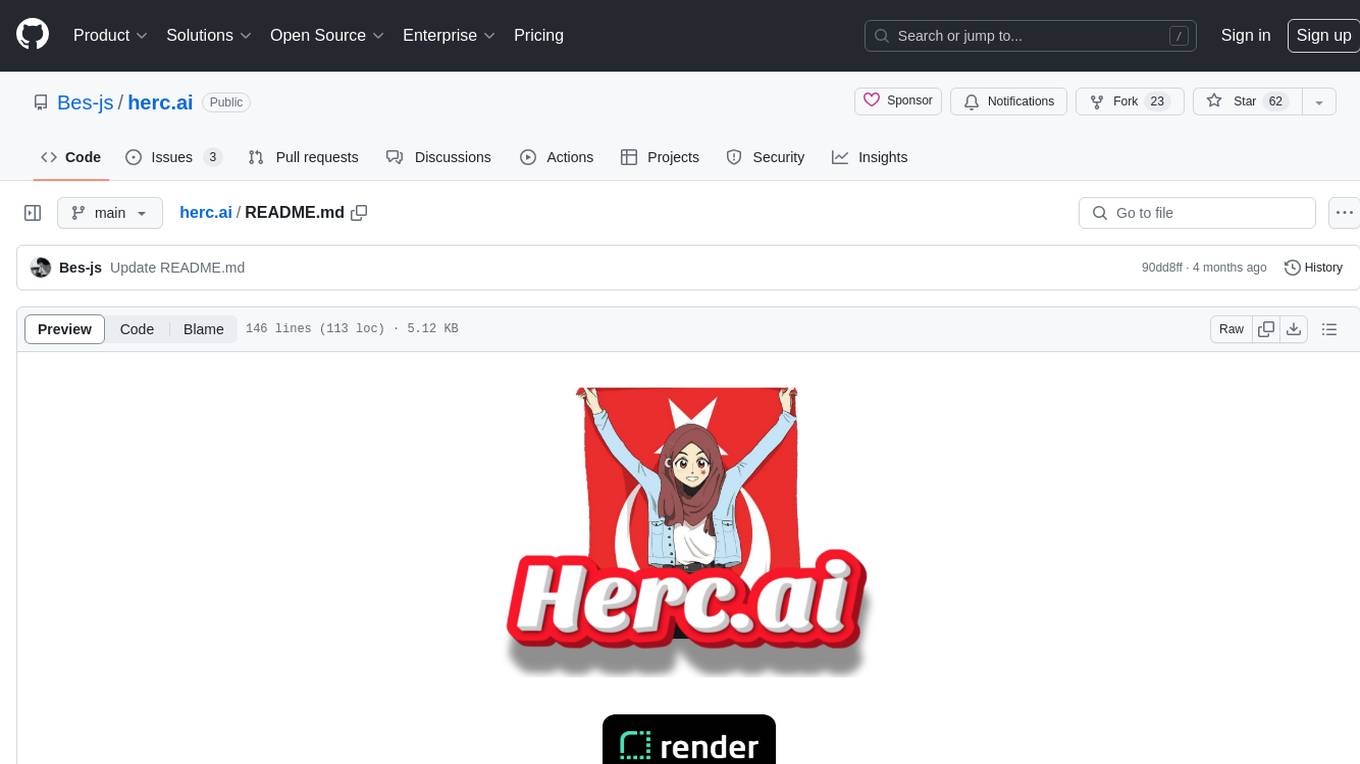
herc.ai
Herc.ai is a powerful library for interacting with the Herc.ai API. It offers free access to users and supports all languages. Users can benefit from Herc.ai's features unlimitedly with a one-time subscription and API key. The tool provides functionalities for question answering and text-to-image generation, with support for various models and customization options. Herc.ai can be easily integrated into CLI, CommonJS, TypeScript, and supports beta models for advanced usage. Developed by FiveSoBes and Luppux Development.
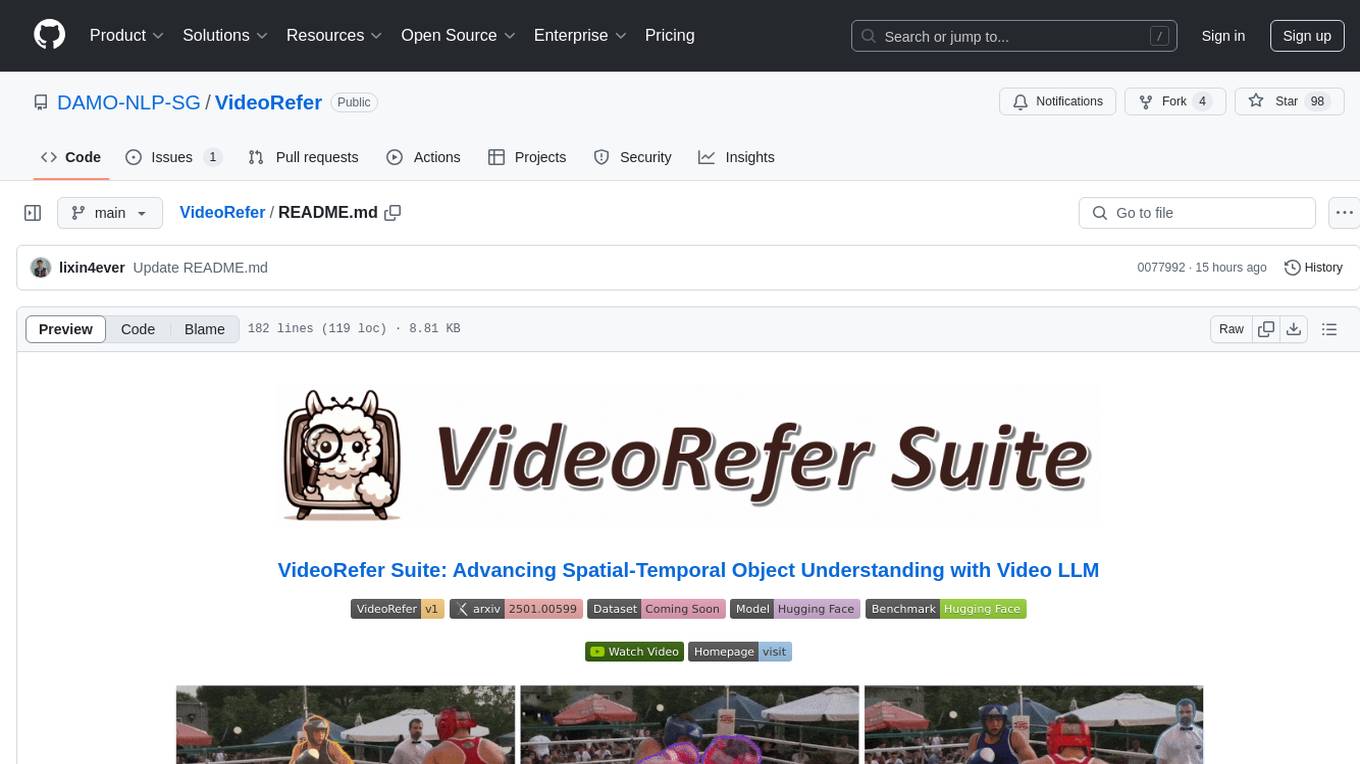
VideoRefer
VideoRefer Suite is a tool designed to enhance the fine-grained spatial-temporal understanding capabilities of Video Large Language Models (Video LLMs). It consists of three primary components: Model (VideoRefer) for perceiving, reasoning, and retrieval for user-defined regions at any specified timestamps, Dataset (VideoRefer-700K) for high-quality object-level video instruction data, and Benchmark (VideoRefer-Bench) to evaluate object-level video understanding capabilities. The tool can understand any object within a video.
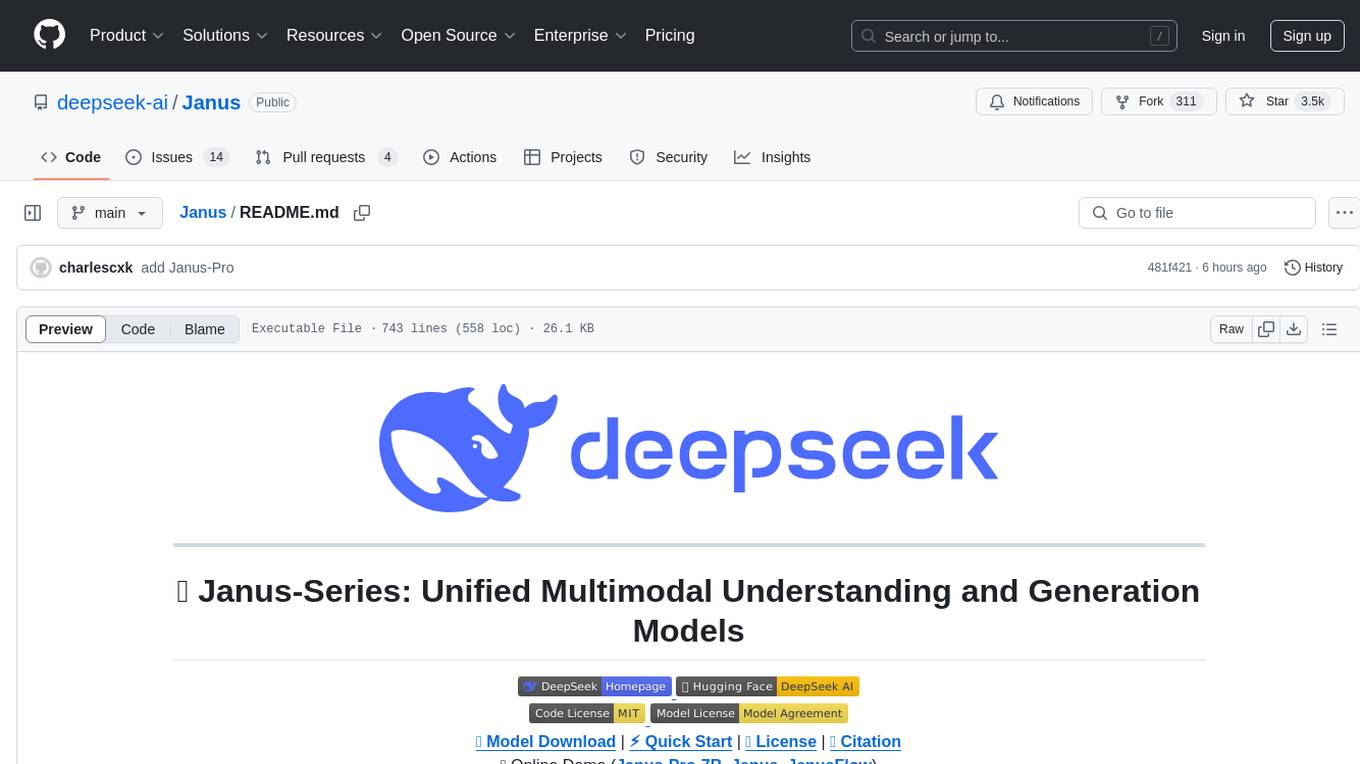
Janus
Janus is a series of unified multimodal understanding and generation models, including Janus-Pro, Janus, and JanusFlow. Janus-Pro is an advanced version that improves both multimodal understanding and visual generation significantly. Janus decouples visual encoding for unified multimodal understanding and generation, surpassing previous models. JanusFlow harmonizes autoregression and rectified flow for unified multimodal understanding and generation, achieving comparable or superior performance to specialized models. The models are available for download and usage, supporting a broad range of research in academic and commercial communities.

aiodocker
Aiodocker is a simple Docker HTTP API wrapper written with asyncio and aiohttp. It provides asynchronous bindings for interacting with Docker containers and images. Users can easily manage Docker resources using async functions and methods. The library offers features such as listing images and containers, creating and running containers, and accessing container logs. Aiodocker is designed to work seamlessly with Python's asyncio framework, making it suitable for building asynchronous Docker management applications.
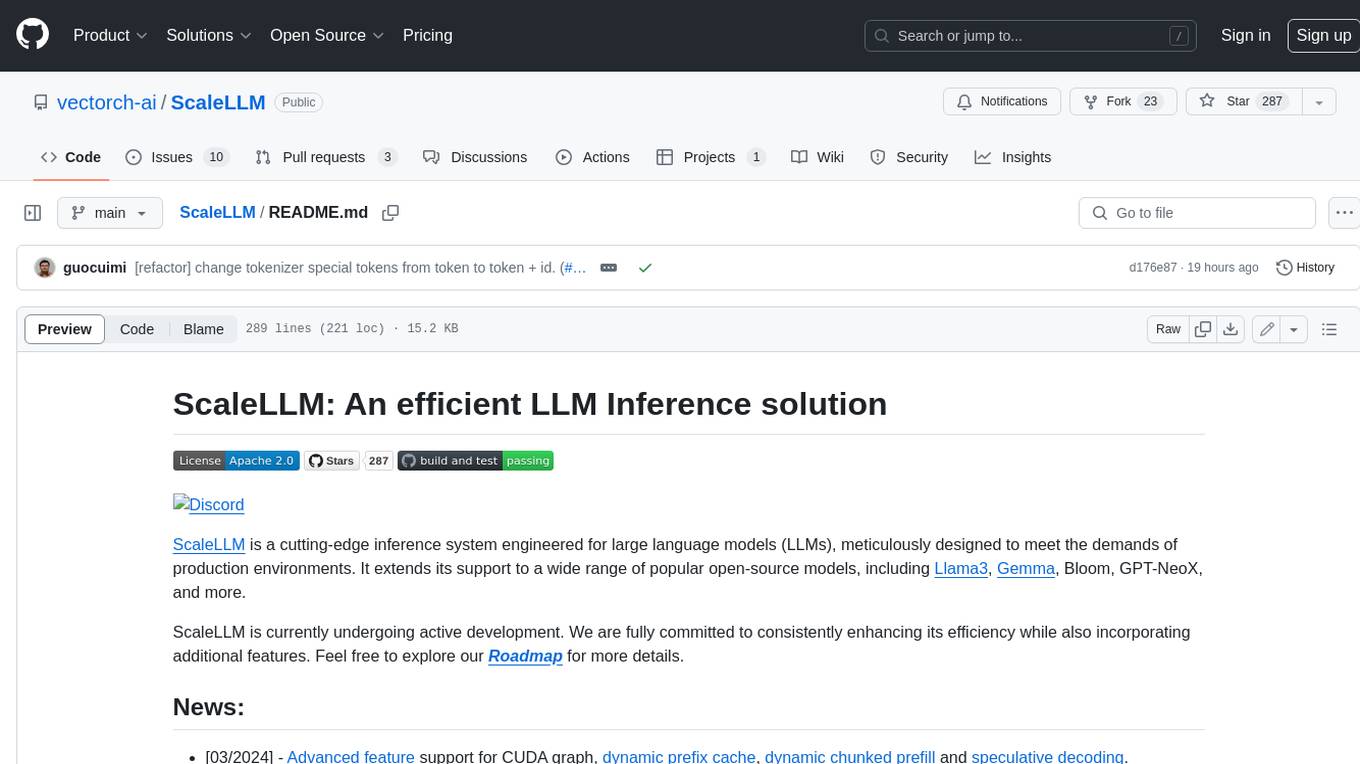
ScaleLLM
ScaleLLM is a cutting-edge inference system engineered for large language models (LLMs), meticulously designed to meet the demands of production environments. It extends its support to a wide range of popular open-source models, including Llama3, Gemma, Bloom, GPT-NeoX, and more. ScaleLLM is currently undergoing active development. We are fully committed to consistently enhancing its efficiency while also incorporating additional features. Feel free to explore our **_Roadmap_** for more details. ## Key Features * High Efficiency: Excels in high-performance LLM inference, leveraging state-of-the-art techniques and technologies like Flash Attention, Paged Attention, Continuous batching, and more. * Tensor Parallelism: Utilizes tensor parallelism for efficient model execution. * OpenAI-compatible API: An efficient golang rest api server that compatible with OpenAI. * Huggingface models: Seamless integration with most popular HF models, supporting safetensors. * Customizable: Offers flexibility for customization to meet your specific needs, and provides an easy way to add new models. * Production Ready: Engineered with production environments in mind, ScaleLLM is equipped with robust system monitoring and management features to ensure a seamless deployment experience.

nonebot-plugin-marshoai
nonebot-plugin-marshoai is a chatbot plugin that utilizes the OpenAI standard format API, such as the GitHub Models API, to enable chat functionalities. The plugin features the character Marsho, a cute cat girl, for engaging conversations. It supports OneBot adapters and GitHub Models API, with limited validation for other adapters. Developed by Melobot.
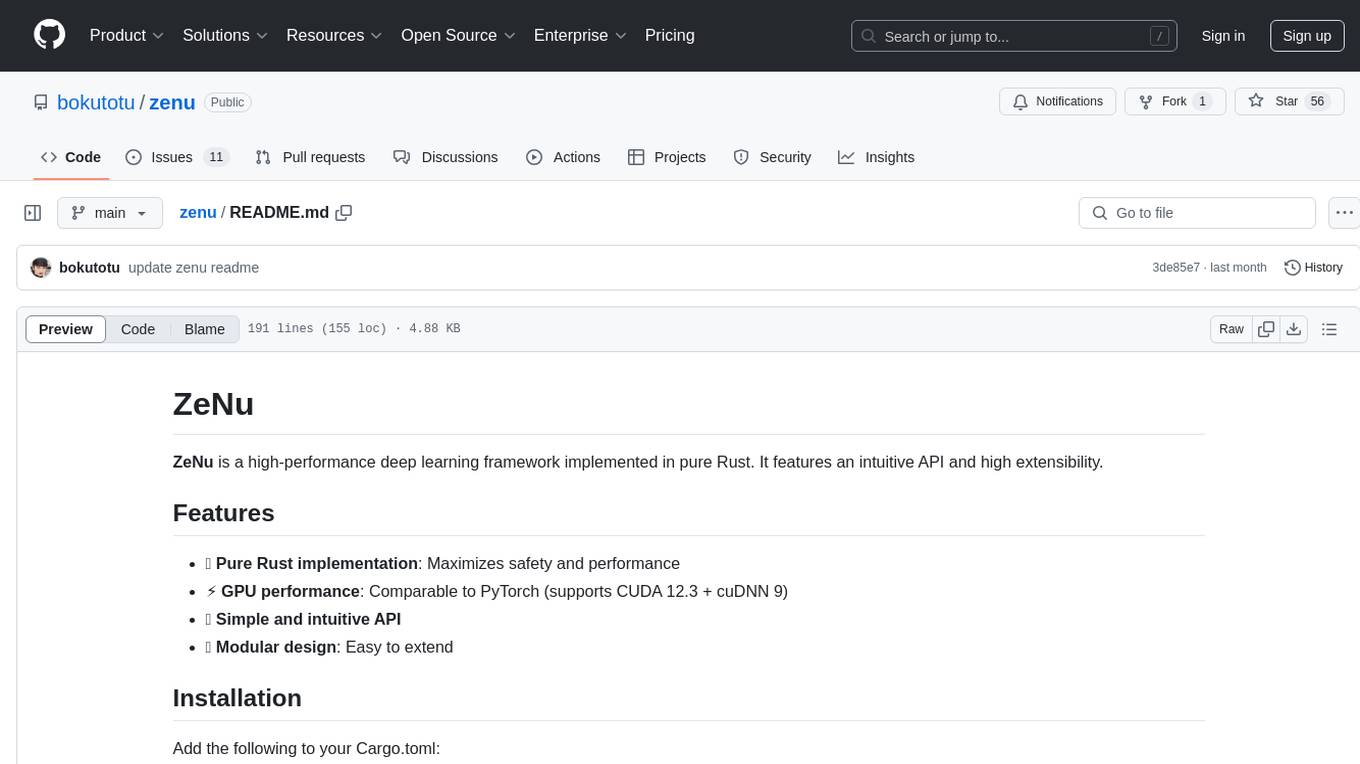
zenu
ZeNu is a high-performance deep learning framework implemented in pure Rust, featuring a pure Rust implementation for safety and performance, GPU performance comparable to PyTorch with CUDA support, a simple and intuitive API, and a modular design for easy extension. It supports various layers like Linear, Convolution 2D, LSTM, and optimizers such as SGD and Adam. ZeNu also provides device support for CPU and CUDA (NVIDIA GPU) with CUDA 12.3 and cuDNN 9. The project structure includes main library, automatic differentiation engine, neural network layers, matrix operations, optimization algorithms, CUDA implementation, and other support crates. Users can find detailed implementations like MNIST classification, CIFAR10 classification, and ResNet implementation in the examples directory. Contributions to ZeNu are welcome under the MIT License.
For similar tasks
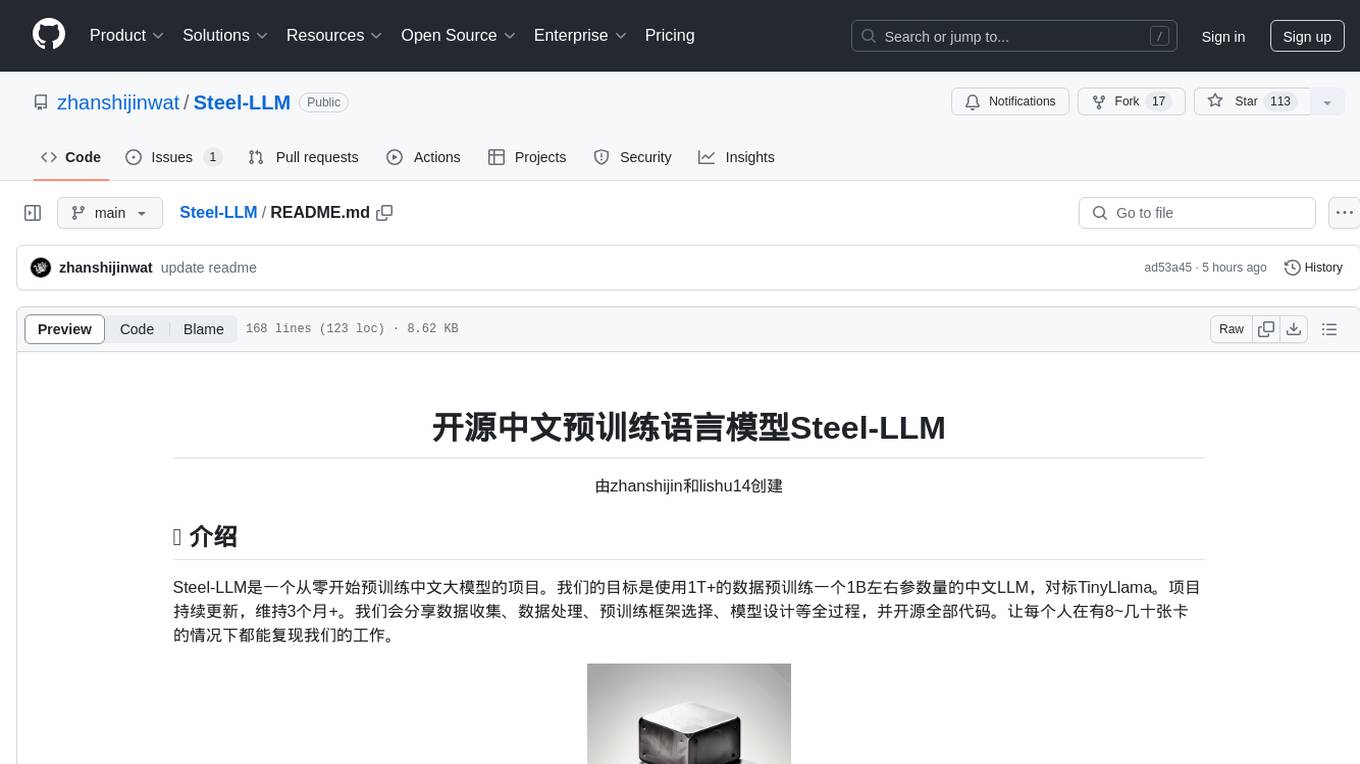
Steel-LLM
Steel-LLM is a project to pre-train a large Chinese language model from scratch using over 1T of data to achieve a parameter size of around 1B, similar to TinyLlama. The project aims to share the entire process including data collection, data processing, pre-training framework selection, model design, and open-source all the code. The goal is to enable reproducibility of the work even with limited resources. The name 'Steel' is inspired by a band '万能青年旅店' and signifies the desire to create a strong model despite limited conditions. The project involves continuous data collection of various cultural elements, trivia, lyrics, niche literature, and personal secrets to train the LLM. The ultimate aim is to fill the model with diverse data and leave room for individual input, fostering collaboration among users.
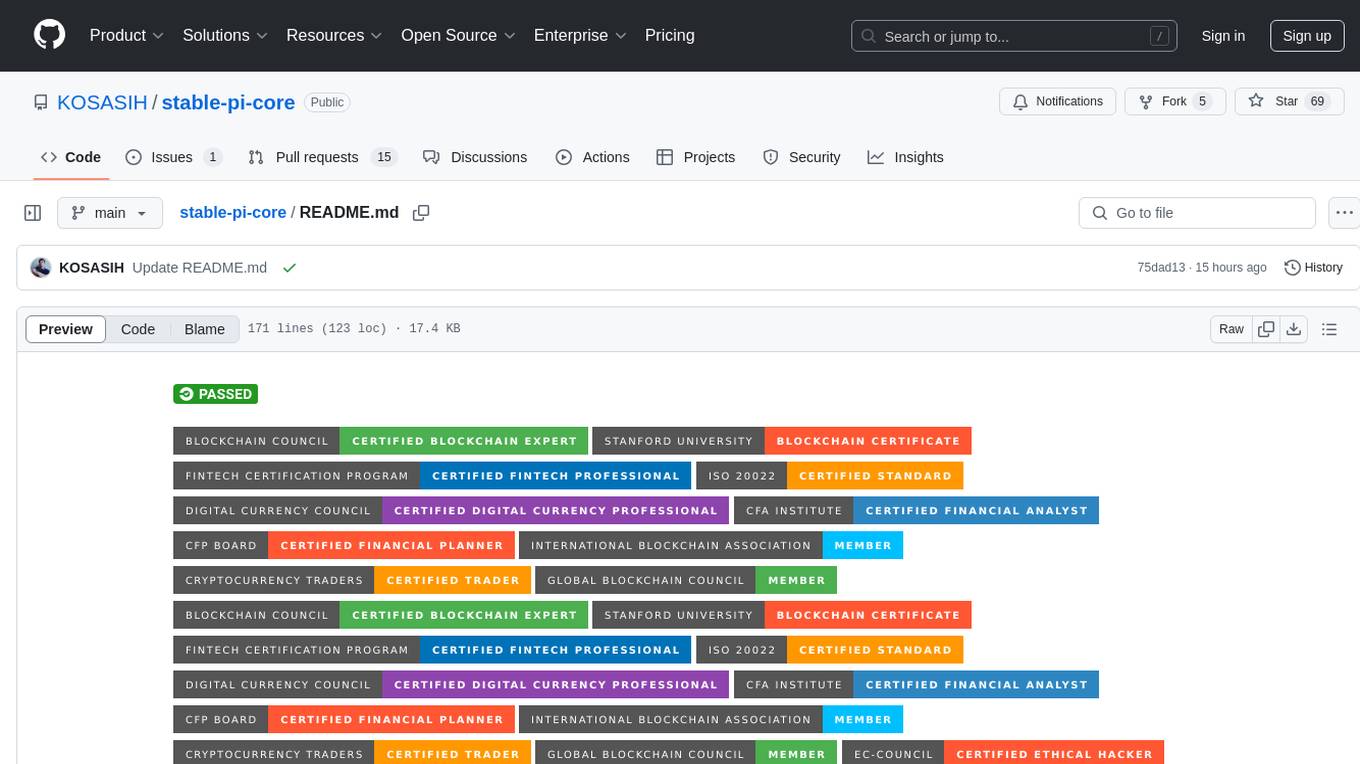
stable-pi-core
Stable-Pi-Core is a next-generation decentralized ecosystem integrating blockchain, quantum AI, IoT, edge computing, and AR/VR for secure, scalable, and personalized solutions in payments, governance, and real-world applications. It features a Dual-Value System, cross-chain interoperability, AI-powered security, and a self-healing network. The platform empowers seamless payments, decentralized governance via DAO, and real-world applications across industries, bridging digital and physical worlds with innovative features like robotic process automation, machine learning personalization, and a dynamic cross-chain bridge framework.

LLaVA-OneVision-1.5
LLaVA-OneVision 1.5 is a fully open framework for democratized multimodal training, introducing a novel family of large multimodal models achieving state-of-the-art performance at lower cost through training on native resolution images. It offers superior performance across multiple benchmarks, high-quality data at scale with concept-balanced and diverse caption data, and an ultra-efficient training framework with support for MoE, FP8, and long sequence parallelization. The framework is fully open for community access and reproducibility, providing high-quality pre-training & SFT data, complete training framework & code, training recipes & configurations, and comprehensive training logs & metrics.
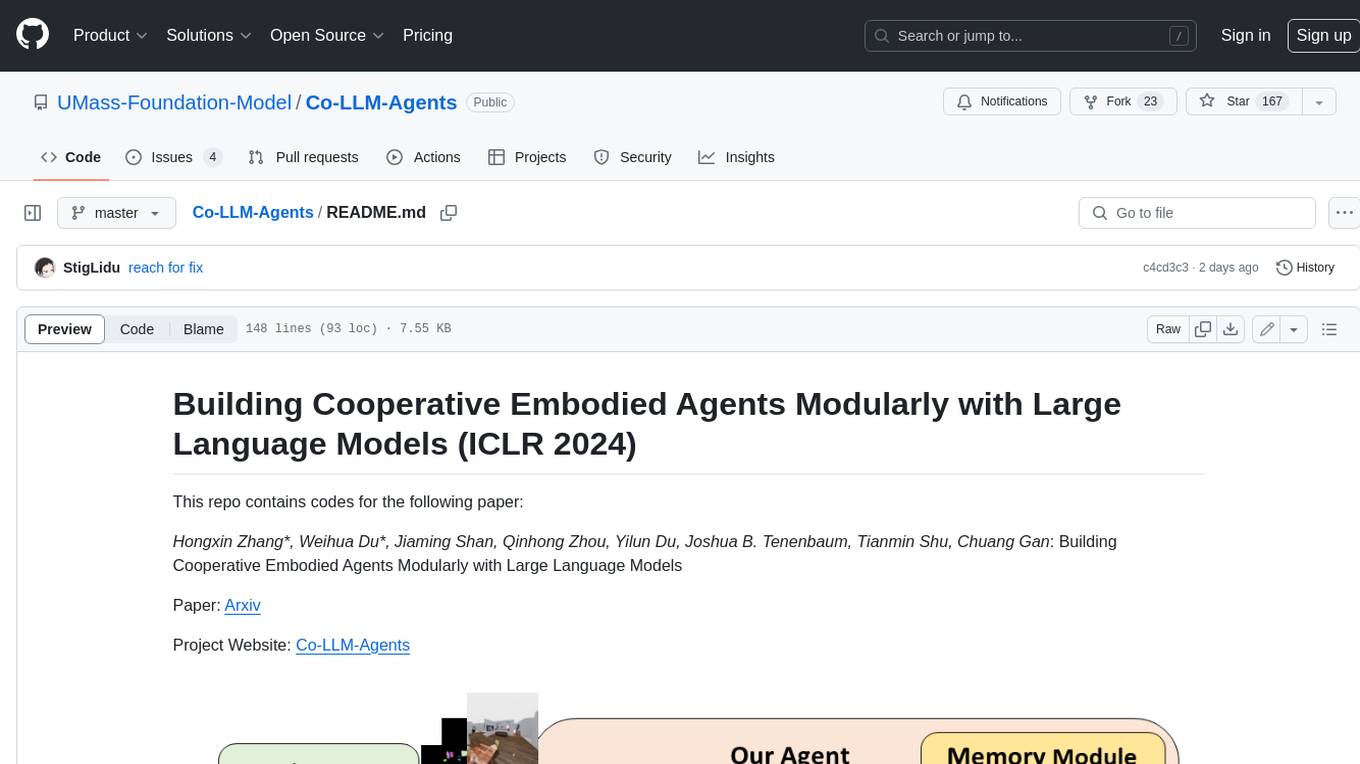
Co-LLM-Agents
This repository contains code for building cooperative embodied agents modularly with large language models. The agents are trained to perform tasks in two different environments: ThreeDWorld Multi-Agent Transport (TDW-MAT) and Communicative Watch-And-Help (C-WAH). TDW-MAT is a multi-agent environment where agents must transport objects to a goal position using containers. C-WAH is an extension of the Watch-And-Help challenge, which enables agents to send messages to each other. The code in this repository can be used to train agents to perform tasks in both of these environments.
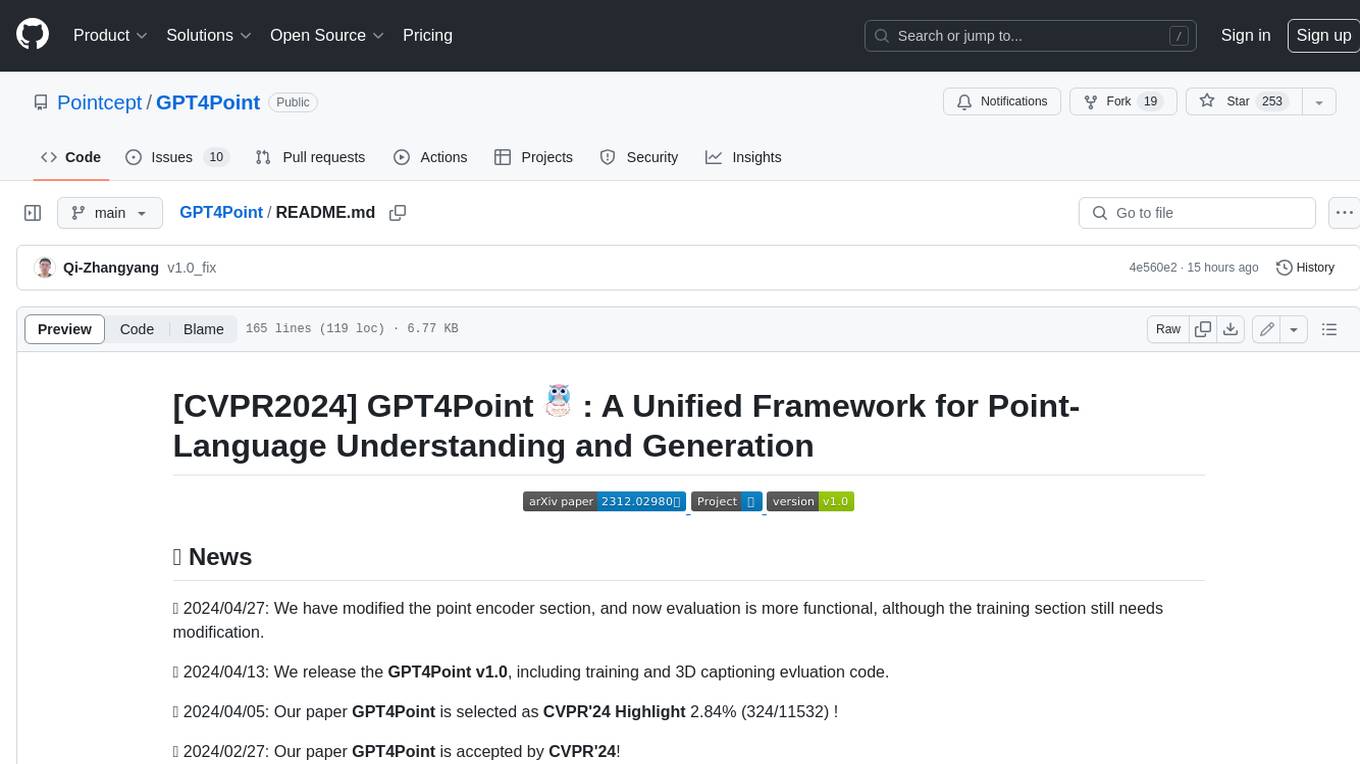
GPT4Point
GPT4Point is a unified framework for point-language understanding and generation. It aligns 3D point clouds with language, providing a comprehensive solution for tasks such as 3D captioning and controlled 3D generation. The project includes an automated point-language dataset annotation engine, a novel object-level point cloud benchmark, and a 3D multi-modality model. Users can train and evaluate models using the provided code and datasets, with a focus on improving models' understanding capabilities and facilitating the generation of 3D objects.
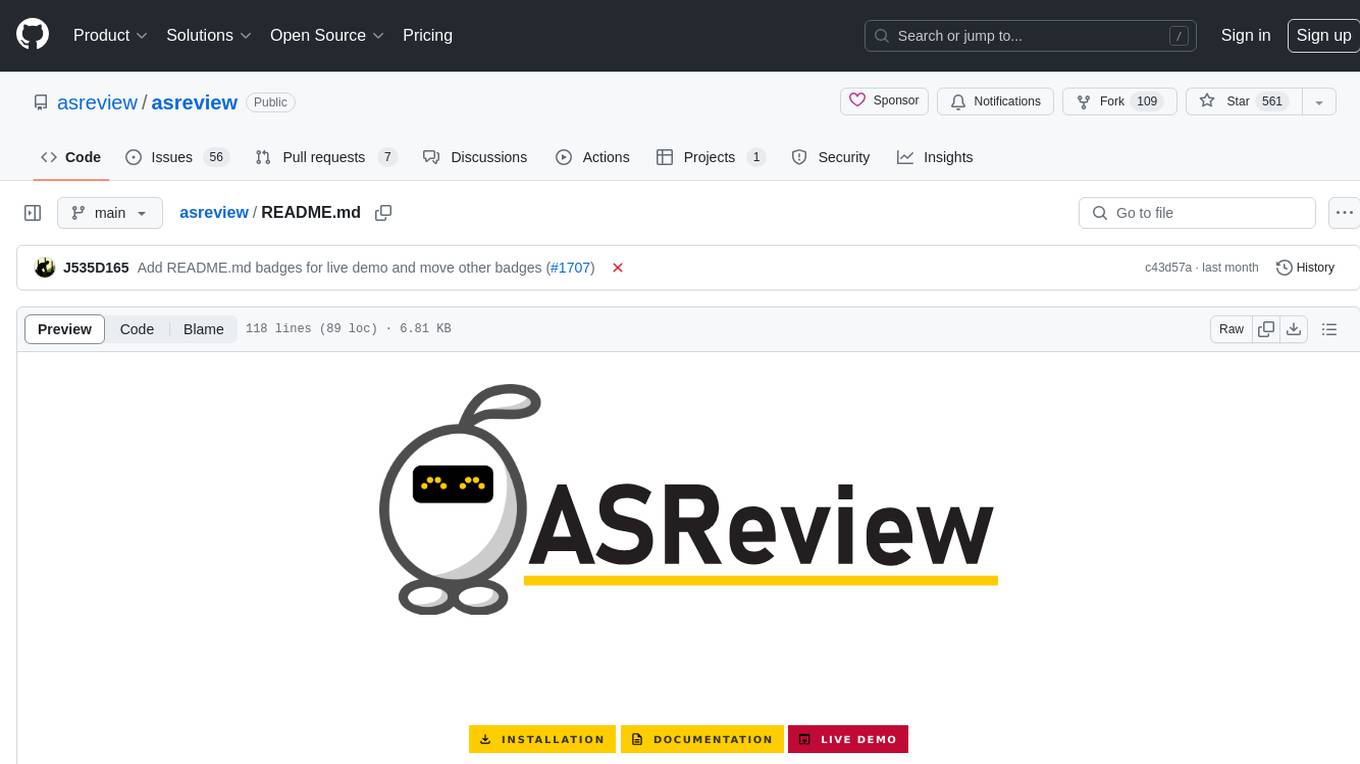
asreview
The ASReview project implements active learning for systematic reviews, utilizing AI-aided pipelines to assist in finding relevant texts for search tasks. It accelerates the screening of textual data with minimal human input, saving time and increasing output quality. The software offers three modes: Oracle for interactive screening, Exploration for teaching purposes, and Simulation for evaluating active learning models. ASReview LAB is designed to support decision-making in any discipline or industry by improving efficiency and transparency in screening large amounts of textual data.
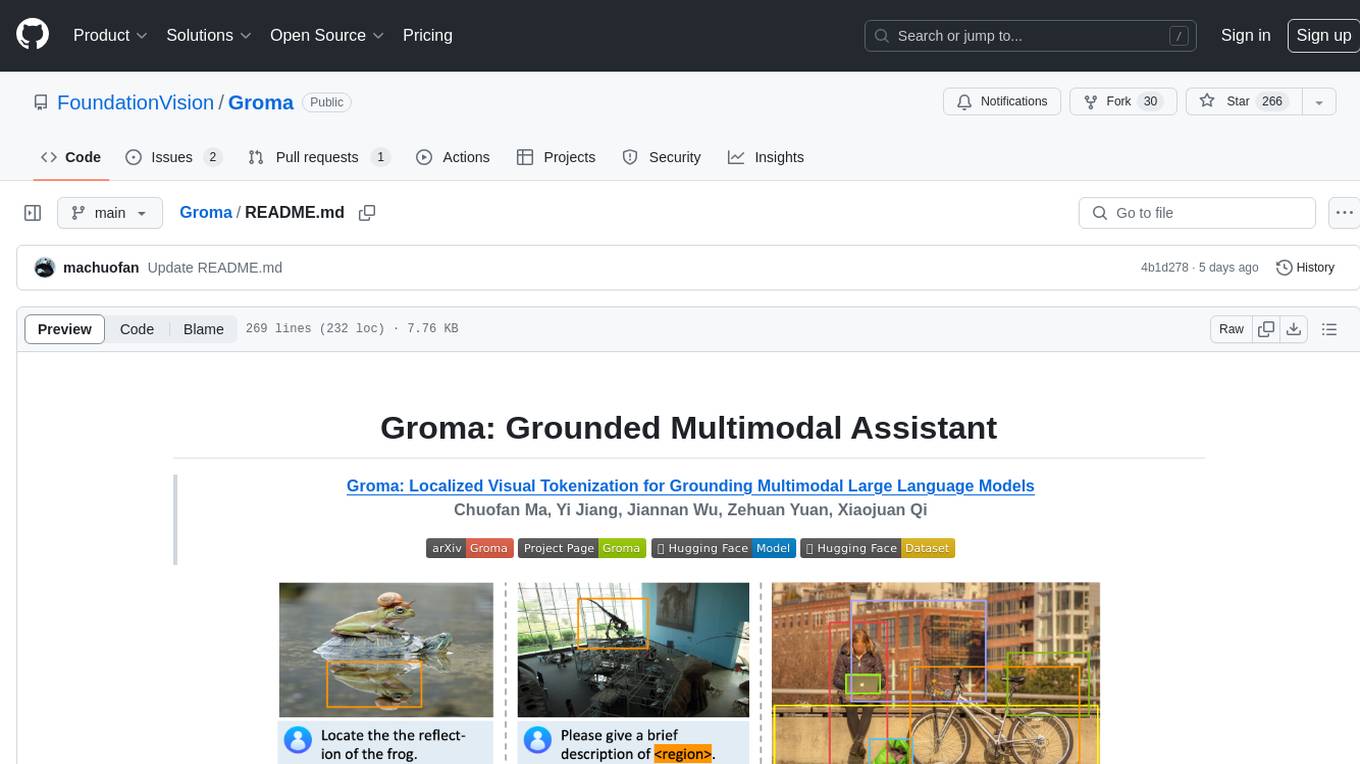
Groma
Groma is a grounded multimodal assistant that excels in region understanding and visual grounding. It can process user-defined region inputs and generate contextually grounded long-form responses. The tool presents a unique paradigm for multimodal large language models, focusing on visual tokenization for localization. Groma achieves state-of-the-art performance in referring expression comprehension benchmarks. The tool provides pretrained model weights and instructions for data preparation, training, inference, and evaluation. Users can customize training by starting from intermediate checkpoints. Groma is designed to handle tasks related to detection pretraining, alignment pretraining, instruction finetuning, instruction following, and more.
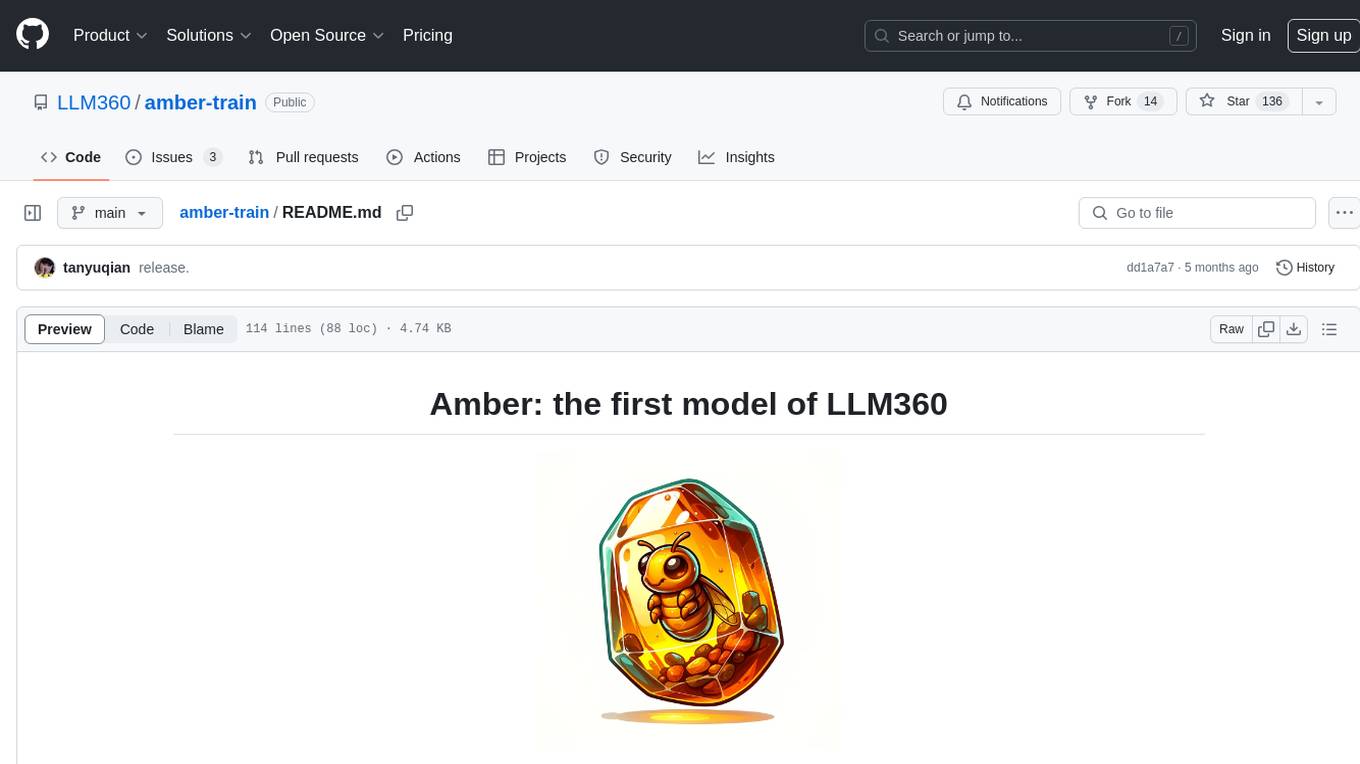
amber-train
Amber is the first model in the LLM360 family, an initiative for comprehensive and fully open-sourced LLMs. It is a 7B English language model with the LLaMA architecture. The model type is a language model with the same architecture as LLaMA-7B. It is licensed under Apache 2.0. The resources available include training code, data preparation, metrics, and fully processed Amber pretraining data. The model has been trained on various datasets like Arxiv, Book, C4, Refined-Web, StarCoder, StackExchange, and Wikipedia. The hyperparameters include a total of 6.7B parameters, hidden size of 4096, intermediate size of 11008, 32 attention heads, 32 hidden layers, RMSNorm ε of 1e^-6, max sequence length of 2048, and a vocabulary size of 32000.
For similar jobs

sweep
Sweep is an AI junior developer that turns bugs and feature requests into code changes. It automatically handles developer experience improvements like adding type hints and improving test coverage.

teams-ai
The Teams AI Library is a software development kit (SDK) that helps developers create bots that can interact with Teams and Microsoft 365 applications. It is built on top of the Bot Framework SDK and simplifies the process of developing bots that interact with Teams' artificial intelligence capabilities. The SDK is available for JavaScript/TypeScript, .NET, and Python.

ai-guide
This guide is dedicated to Large Language Models (LLMs) that you can run on your home computer. It assumes your PC is a lower-end, non-gaming setup.

classifai
Supercharge WordPress Content Workflows and Engagement with Artificial Intelligence. Tap into leading cloud-based services like OpenAI, Microsoft Azure AI, Google Gemini and IBM Watson to augment your WordPress-powered websites. Publish content faster while improving SEO performance and increasing audience engagement. ClassifAI integrates Artificial Intelligence and Machine Learning technologies to lighten your workload and eliminate tedious tasks, giving you more time to create original content that matters.

chatbot-ui
Chatbot UI is an open-source AI chat app that allows users to create and deploy their own AI chatbots. It is easy to use and can be customized to fit any need. Chatbot UI is perfect for businesses, developers, and anyone who wants to create a chatbot.

BricksLLM
BricksLLM is a cloud native AI gateway written in Go. Currently, it provides native support for OpenAI, Anthropic, Azure OpenAI and vLLM. BricksLLM aims to provide enterprise level infrastructure that can power any LLM production use cases. Here are some use cases for BricksLLM: * Set LLM usage limits for users on different pricing tiers * Track LLM usage on a per user and per organization basis * Block or redact requests containing PIIs * Improve LLM reliability with failovers, retries and caching * Distribute API keys with rate limits and cost limits for internal development/production use cases * Distribute API keys with rate limits and cost limits for students

uAgents
uAgents is a Python library developed by Fetch.ai that allows for the creation of autonomous AI agents. These agents can perform various tasks on a schedule or take action on various events. uAgents are easy to create and manage, and they are connected to a fast-growing network of other uAgents. They are also secure, with cryptographically secured messages and wallets.

griptape
Griptape is a modular Python framework for building AI-powered applications that securely connect to your enterprise data and APIs. It offers developers the ability to maintain control and flexibility at every step. Griptape's core components include Structures (Agents, Pipelines, and Workflows), Tasks, Tools, Memory (Conversation Memory, Task Memory, and Meta Memory), Drivers (Prompt and Embedding Drivers, Vector Store Drivers, Image Generation Drivers, Image Query Drivers, SQL Drivers, Web Scraper Drivers, and Conversation Memory Drivers), Engines (Query Engines, Extraction Engines, Summary Engines, Image Generation Engines, and Image Query Engines), and additional components (Rulesets, Loaders, Artifacts, Chunkers, and Tokenizers). Griptape enables developers to create AI-powered applications with ease and efficiency.













